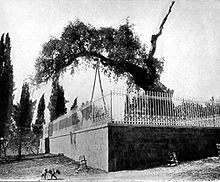Oak of Mamre


The Oak of Mamre (also called the Oak of Sibta), at Khirbet es-Sibte (also as Ain Sibta), in Hebron in the West Bank is a site venerated by some as the "Oak of Abraham". It is distinct from the more ancient site of Mamre. It owes its name to an ancient tree, which seems to be dead but has a young sprig growing next to it, and stands on the grounds of the modern Russian Orthodox Monastery of the Holy Trinity.
The old tree fell in 2019, but there are plans to preserve its trunk and sustain the growth of the young shoot.[1]
The site is located two kilometres (1.2 miles) southwest of Mamre, historically near Hebron[2] and now inside the city. Also called The Oak of Abraham,[3] it is an ancient oak tree (Quercus coccifera) which, in one tradition, is said to mark the place where Abraham entertained the three angels[4] or where Abraham pitched his tent.
Different tradition until 1150s[]
This site is distinct and at a different location from the site considered as Mamre by Herod the Great, Josephus, Constantine the Great, early Church historians and Christian pilgrims all until the mid-12th century, such as Arculf and Abbot Daniel. That site is at a location called in Arabic Ramat al-Khalil (the older name used by archaeologists) and currently Bir al-Haram ar-Rameh, which is a few kilometres north of the site described in this article. After the mid-12th century, the traditional location of the Oak of Mamre migrated to different sites, the most prominent being the current location outside the church.
History[]


As written in a footnote from an 1895 publication of Arculf's pilgrimage report,
The Oak or Terebinth of Abraham has been shown in two different sites. Arculf and many others (Jerome, Itin[erarium] Hierosol[ymitanum], Sozomen, Eucherius [possibly Eucherius of Lyon], Benjamin of Tudela, the Abbot Daniel,.... etc.) seem to point to the ruin of er Râmeh, near which is Beit el Khulil, or Abraham's House, with a fine spring well. This is still held by the Jews to be the Oak of Mamre. The Christians point to another site, Ballûtet Sebta, where [there] is a fine specimen of Sindian (Quercus Pseudococcifera)."[5]
Ballut is the Arabic word for oak.
The site of the oak was acquired in 1868 by Archimandrite Antonin (Kapustin) for the Church of Russia, and the Monastery of the Holy Trinity was founded nearby. The site has since been a major attraction for Russian pilgrims before the revolution, and is the only functioning Christian shrine in the Hebron region. After the Russian Revolution, the property came under the control of the ROCOR.
A long-standing tradition is that the Oak of Abraham will die before the appearance of the Antichrist. The main oak trunk has appeared to be dead since 1996.[6][7] Following construction work in the 1970s, a wooden ring in the form of a chalice was built around the tree, and its roots began to die. In 1997, a small sprig was seen growing near the withered oak. In October 2016, Russian botanists began a project to save the tree.[8] In 1998 a root sprout appeared.[9]
The Hebron Monastery has emerged as a political issue between Russia and Palestinian authorities.[10][11]
References[]
- This article incorporates text from Oak of Mamre at OrthodoxWiki which is licensed under the CC-BY-SA and GFDL.
- ^ "Пророчество о конце света: в Хевроне рухнул Дуб Авраама // НТВ.Ru". February 10, 2019. Archived from the original on February 10, 2019.
- ^ Genesis 13:18 Then Abram removed his tent, and came and dwelt in the plain of Mamre, which is in Hebron, and built there an altar unto the LORD(KJV)
- ^ The Hebrew term Eloney Mamreh of Genesis 13:18 is considered by some translators to be a name of a region in Canaan. Other scholars dispute this and suggest that it is the reference to the terebinth trees of Mamre; or to the Oak of Mamre, which is now known as Abraham's Oak
- ^ New Challenge for Arafat: A Russian Church by Serge Schmemann for the New York Times, July 11, 1997.
- ^ Macpherson, James Rose (transl., ed.) (1895). Arculf's Narrative about the Holy Places, Written by Adamnan. Book I. The Pilgrimage of Arculfus in the Holy Land (About the Year A.D. 670). PPTS Publications. Vol. 33. London: Palestine Pilgrims' Text Society (PPTS). pp. 33–34 fn. 1. Retrieved 2016-07-15.
|volume=has extra text (help) - ^ "Hebron's holy tree is dead but its successors live". accessmylibrary.com. 27 December 1996.
- ^ "Rome News-Tribune – Google News Archive Search". google.com.
- ^ "Russian experts will work in Palestine to save the Oak of Mamre mentioned in Bible". Interfax. October 24, 2016.
- ^ "Российские специалисты проанализировали состояние Мамврийского дуба". pravoslavie.ru.
- ^ Nofal, Aziza (2019-01-04). "Hebron's only Orthodox church quiet on Christmas". Al-Monitor. Retrieved 2020-06-10.
- ^ Schmemann, Serge (1997-07-11). "Arafat Enters Into a New Fray, Over a Russian Church". The New York Times. ISSN 0362-4331. Retrieved 2020-06-10.
External links[]
- Video tour in English of Oak of Mamre and Holy Trinity Church in Hebron on YouTube
- A brief compendium of Abraham's Oak or the Oak of Mamre On Madain project Oak of Abraham - Madain Project (en)
- Religious places
- Individual oak trees
- Trees in religion
- Individual trees in the Palestinian territories
- Religion in Hebron